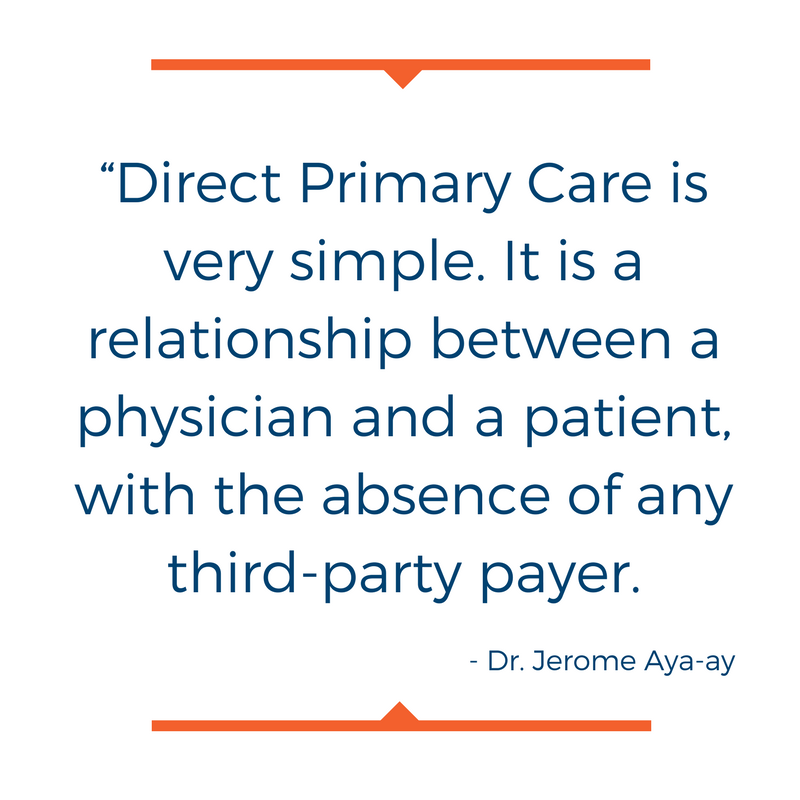On healthcare: back to the basics or new innovation?
Healthcare is expensive, but it does not have to be. Certain family-practice doctors in South Carolina are blazing the trail and saving patients thousands of dollars each year through a medical practice model called Direct Primary Care.
Dr. Jerome Aya-ay is a family medicine practitioner with offices in Greenville, Spartanburg and Columbia, SC. He doesn’t take payment from any insurance companies or from Medicaid. Instead, for $60 per month, his patients have access to all the primary care they need.
Palmetto Promise Institute met with Dr. Aya-ay in his Spartanburg office to talk with him about how Direct Primary Care works, why he’s able to offer such affordable care and what the future holds for Direct Primary Care.
PPI: What is Direct Primary Care?
Dr. Aya-ay: Direct Primary Care is very simple. It is a relationship between the physician and the patient with the absence of any third-party payer – in particular, insurance companies.
PPI: So the crucial difference between Direct Primary Care and the “traditional insurance model” is that you have no interaction with insurance companies?
Dr. Aya-ay: We do not. We accept payment from the patient or the patient’s employer.
If you come in the door, all we will ask you for is you ID and a telephone number so we can call you back about any lab results. We don’t ask about Medicaid or what insurance you might carry. Direct Primary Care, simply put, is a transaction between the patient and myself, the physician.
A lot of times we only find out if a patient has a form of insurance only when they need it. For example, if we determine it’s time for maybe an imaging study – say an MRI – the patient will often tell me, “well I have Medicaid or BlueCross BlueShield, can I use that?” And we say, “absolutely, you can pay specialists that we refer you to with insurance coverage.” But most of the time, we just don’t ask. Medicaid patients or insurance patients pay us out of pocket.
PPI: What are the biggest benefits to the patient of using a Direct Primary Care modeled medical clinic instead of a “traditional medical clinic.”
Dr. Aya-ay: The biggest advantages are access, time spent in the room with the patient, and cost. $60 per month, 24/7 access to me, visits whenever they are needed – 10 minutes, 30 minutes, you have a tragedy and need 45 minutes or an hour, I’m available. There is no second guessing what you are going to pay. If you’re a member, you are going to pay $60 per month and we have everything listed – you get two x-rays per year, all your visits about 90% of your labs (if you’re a diabetic and need to check your sugar for the past three months, need a complete metabolic panel? That’s included. Lipid panel? That’s included). All these labs that we determine are needed to keep our patients healthy, we make available in the membership. $720 per year? We say, yes!
We get paid to think and we take great pride in making a living for our families and helping our employees make a living, but we do not need astronomical prices.
And we are able to keep prices low. Consider this. I think this data is from 2010, but a traditional family medicine practice pays about $90,000 per physician, per year, to push paper – to do every administrative duty to get paid through insurance. So if Dr. McCarthy and I were to open up this clinic under the “traditional model,” we’d be in the hole $180,000. And then accounts receivable comes in 30 to 90 days when you wait for payment from the insurance company. So it’s not a great way to do business. That’s why more private doctors in the “traditional model” are giving it up and being absorbed by the big hospital systems.
PPI: And you’ve seen success with the Direct Primary Care model?
Dr. Aya-ay: A story that happens here almost every day. A patient comes in and says, “my company changed my insurance plan and now instead of having ‘good insurance,’ I have ‘bad insurance’ (which means their deductible is higher). Almost every Fortune 500 company decided to shift how they offered insurances to their employees when President Obama decided to require everyone to have health insurance.
Companies now say, “you have three choices and the deductibles are all over $1000.” The patient comes in, their deductible is $5000 and they ask “how can you help me?”
I saw a patient recently with six medications. Two of them were free at Bi-Lo – diabetes and blood pressure medicine – and the rest were maybe $4 elsewhere. They had been paying $80 per month, we got it down to $20. Guess what, we saved them their membership – $60 per month.
PPI: What are the biggest benefits from the perspective of the physician?
Dr. Aya-ay: If you go into medicine to be a family care doctor, it is what you signed up for. Direct Primary Care is the old-school way of doing medicine. The advantage to the physician is that you’re a doctor again. You’re not a hamster in the wheel trying to get through patients, getting paid according to doctor’s contracts. You don’t have to “churn-n-burn” or “treat-n-street” patients. As a physician, it gives me that satisfaction that I’m doing what’s right for the patient.
Typically a family doctor sees between 30 and 40 patients per day. We want our doctors here to see 15 patients per 8 to 9 hour day. That’s very reasonable. We get less burned out and we can really enjoy what we do.
I can get to know my patients my patients can get to know me.
Just recently I was at a function downtown and a member called me. He had gotten hurt at work. I met him at the office, sewed up the wound and then went back to the function. Whereas if you work for some hospital systems, you can’t do that, because you’re required to generate a charge. Here though, its built into the membership charge.
PPI: What is the difference between Concierge Care and Direct Primary Care? People often equate the two, but that’s not exactly fair is it?
Dr. Aya-ay: Concierge Care means you basically pay a cover charge just to be a member and then they also charge your insurance as well. In Direct Primary Care, everything is included in that monthly charge – we don’t bill your insurance.
PPI: So Concierge Care is often attractive to upper-income people that can afford it?
Dr. Aya-ay: Right. And that is something my partner, Dr. McCarthy, and I, were really intentional about. We know there is a safety net that is built to take care of lower-income South Carolinians and we know upper-income South Carolinians can take care of themselves. But the people in the middle, the lower to upper-middle class, they need help, and no one is really helping them. So we were really intentional about being accessible to the middle-class.
I was giving a talk in Spartanburg one time and someone asked me whether I felt bad about not being as accessible to lower-income people. I wish I could serve everyone, but there are avenues for medical care in the lower and upper income brackets already. People in the middle-income brackets are being left out.
You know, middle-income people are so busy, their voice isn’t really heard. They are working 60 to 80 hours per week and they come in here with 2 or 3 jobs, paying $800 to $1000 per month with a $300 deductible.
To read the second part of the interview, click here.




